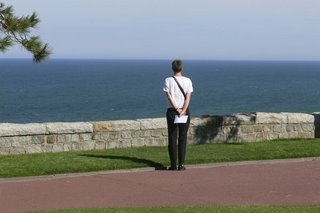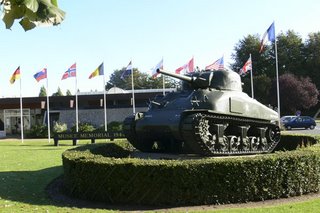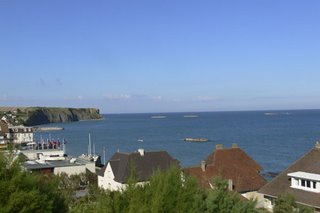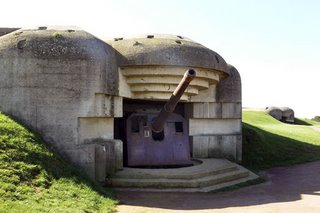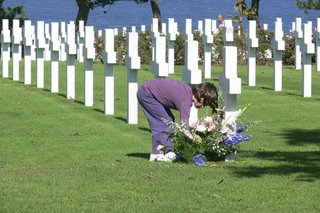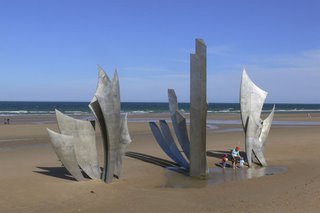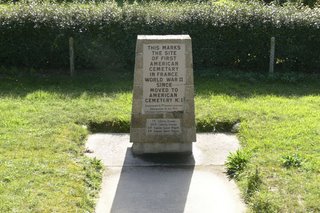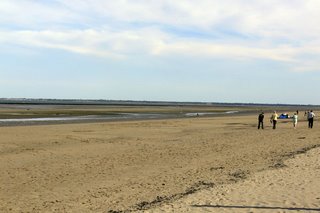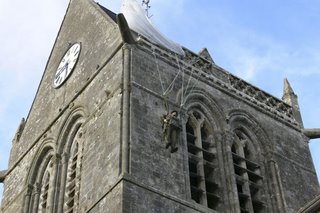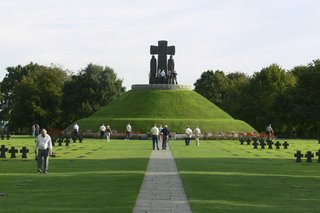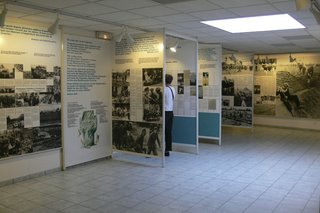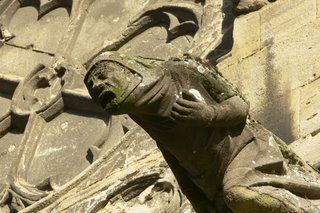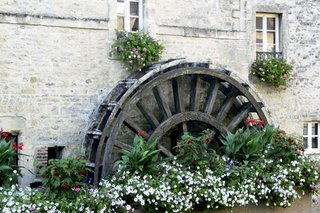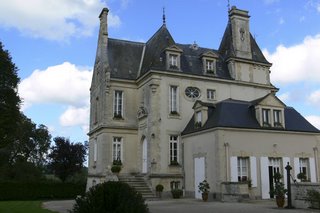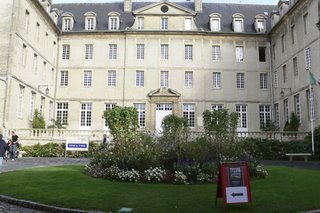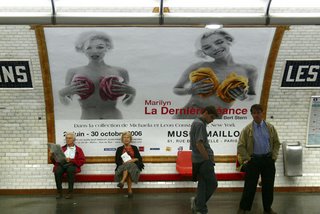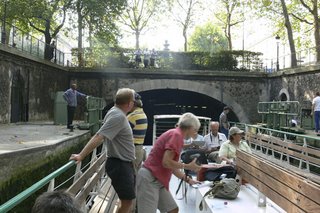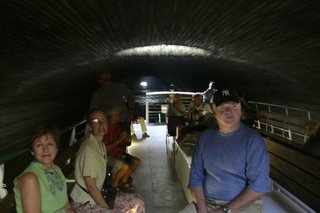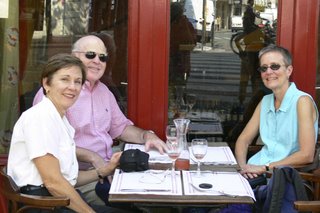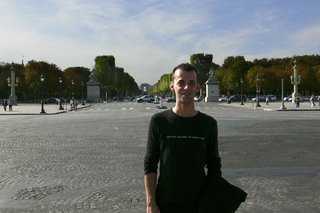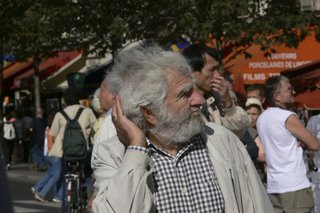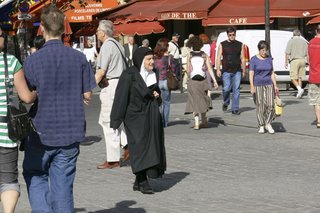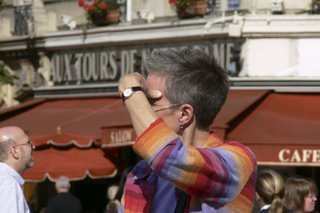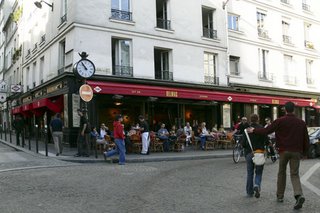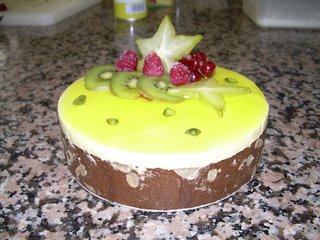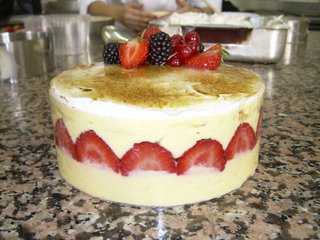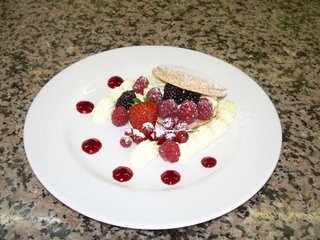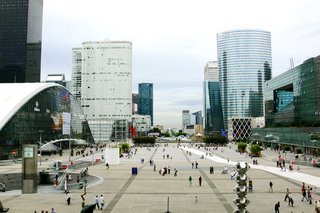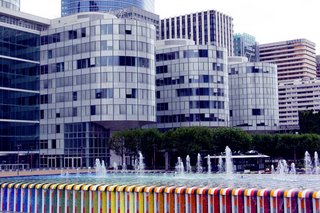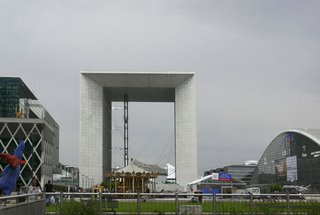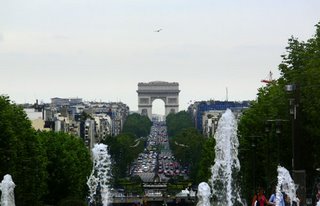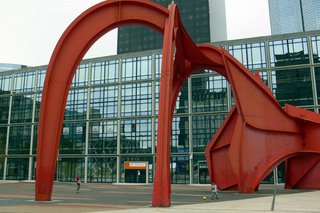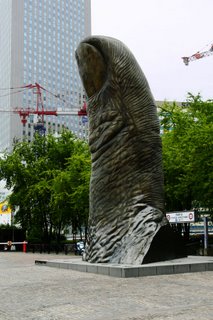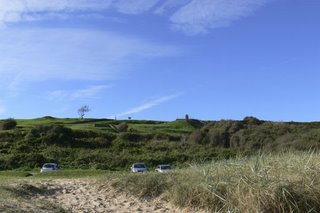
After returning to the B & B last evening we changed clothes and headed back into Bayeux for dinner on, that’s right, rue des Cuisiniers. This time though we ate at “Le Petit Bistro”, which was very “petit” indeed, with tables seating about 16 people, four of those outside. Located not 50 feet from “Le Pommier”—where we ate the previous evening -- this restaurant is run by a young husband and wife. They served some of the best tasting, most creative food we have eaten in a long time, and certainly ranks among the best we had eaten in France. The presentations of each course were themselves worth the price of the meal: using cool glass, stone, and porcelain in imaginative ways. For example, my dessert was a “galette” of chevre on a blini with greens on top and drizzled with honey, all on a large piece of slate. And was it good! We each had for our main course (“plat”) pork that was literally falling off the bone, prepared in a vanilla sauce, with a scrumptious puree of squash for the dipping sauce! Prices were even better than the night before: the meal with wine came to a little over €60 for the two of us! (photo: looking up from Omaha beach to the German machine gun bunkers.)
After another quiet night and sound sleep we awoke to another beautiful morning in Normandy. Susan and I debated whether to go to Mont Saint Michel on our way back to Paris or somewhere else. At breakfast Mark and Kate – the biking couple from Colorado – informed us that we had in fact missed an important part of Omaha beach, the eastern end, and that settled it: we were going back to Omaha.
The four of us spent a good portion of the morning chatting over coffee – served in cups the size of soup bowls with handles -- and croissants, swapping travel stories. In particular we gleaned from Mark and Kate some great information about their recent excursion into the Loire valley – they had been spending some serious quality time in France. So now we’re already starting to put together an outing down to Amboise along the Loire later in October based on their suggestions. You just can’t beat the personal experience of other travelers, particularly the seasoned ones.
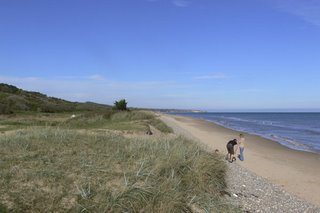
After packing our car, paying the bill and saying au revoir to Mark and Kate and to our hosts Sophie and Thibault, Susan and I headed back to Omaha beach for one last look before returning to Paris. From our B & B we drove on a little back road straight to the coast road, turned left and then a few kilometers later right as we entered Colleville-sur-Mer we took the first turn off to the Beach, before the American cemetery. We drove through a marvelous little wooded lane, actually a ravine leading down to the beach. As you approach the beach, on the right, or to the east there is a track which apparently leads to a playground and place for campers to park; we stayed straight and to the left on a pretty rough track which eventually ended in a small car park. (photo: looking west from Omaha beach just below the American cemetery.)
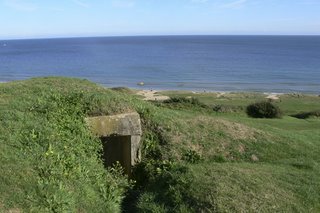
We got out and could see a group of German bunkers just above us and to the right of which was the American cemetery. It all looked so peaceful of course and we strained to imagine what it must have been like for thousands of men to be huddled along the shoreline, with hundreds dying by the hour; the tremendous violence, the very intensity of every moment, as they struggled to survive in a few meters of space, face buried in the “shingle”, the line of pebbles running along this portion of the beach (which is still there today), constantly looking above them, wondering if they were ever going to get off that Beach and get up on top of that hill. And whether they would survive the next minute. The next hour let alone the day. (photo: entrance to German machine gun bunker overlooking Omaha beach.)
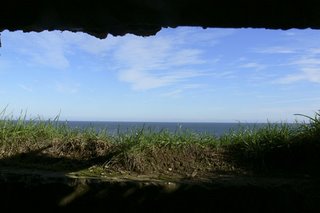
And many of those boys are still on that hill today watching over the Beach. (photo: view of the Omaha beach from inside the bunker.)
Walking up to the 1st US Inf. Div. memorial on top of the bluff directly above the car park we passed the series of bunkers, which on that morning must have contained hundreds of Germans equally determined to prevent these men from getting off the Beach. You can even go inside one today.
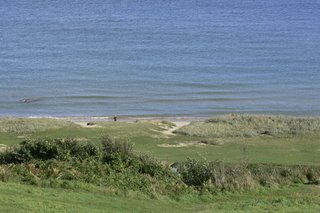
As I looked out and down to the Beach I wondered: did the men huddling behind their machine gun beneath this piece of concrete stop and ask themselves what would happen if these men did get off the beach? Did they give any thought to the larger issues at stake in this Beach? Or did they just get about their work as best they could, which mainly consisted of killing as many of those men on the beach as possible, all the while trying to stay alive? I suspect everything probably happened way too fast for any contemplation. To us today casually strolling these Beaches we forget that time is our friend: we don’t have to be anywhere until 6 o’clock or 9 o’clock; we don’t have to have the car back until tomorrow or whatever. For those men both on the beach and along the bluffs above, time was everything: for those on the Beaches time probably seemed to stand still and yet before long the day was gone and the beginning of the end of the Third Reich was at last underway. For the men on the bluffs looking down on the Beach time was fast running out. (photo: view of the Omaha beach from inside the bunker.)
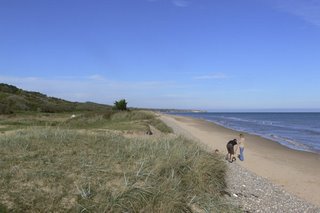
On June 9, Captain R. G. Shinnan of the Regina Rifles, 7th Brigade of the 3rd Canadian Division, which had landed on Juno beach on June 6, was killed in action during an attempted German armored counterattack. Captain Shinnan is buried in the Canadian cemetery at Bency-sur-Mer. His headstone reads: “God alone understands.” And that probably sums up best what I took away from my trip to this hallowed place. (photo: view of the "shingle" on Omaha beach.)
One could spend a lifetime reading about war, this war and this battle and still never know exactly what happened that day or why. But it is in the effort to know that comes understanding of a sort.
Susan and I returned to the car, left Omaha Beach and east back to Paris.
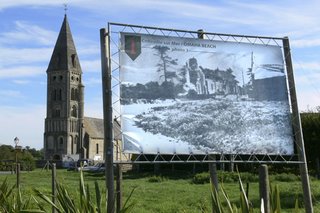
On our way out of Colleville-sur-Mer, as we slowed going through the small village, we noticed the churchyard was open (so many of them seemed to be closed, locked and gated) and so we stopped for a few moments. And what we saw here near the church was striking. The townspeople have four huge copies of photographs taken shortly after D-Day onto large canvas panels and strung them in such a fashion as to provide the passerby today with twin views of the church and crossroads: the photographic “then” juxtaposed with the “now” reality. Eerie and very powerful. Don’t miss this.

Along the way toward Caen we stopped at Juno beach, where the Canadian 3rd division came ashore under heavy fire on June 6. Set amidst a series of high-rise apartment buildings – for vacationers one suspects—and next to a marina packed with pleasure boats you’d hardly think that anything of importance ever happened here. But it did. (photo above: off of Juno beach today.)
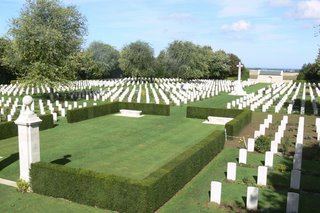
And just a few kilometers away clear proof of the terrible things that occurred along this stretch of farmland in June of 1944: the Canadian cemetery at Bency-sur-Mer. Located amid flat, fertile farms, so much like their own back in Canada one soldier reported, the cemetery sits quietly alone in a beautiful cluster of trees. Very few visitors stop by here I suspect – it is a bit off the beaten path and you do really have to be looking for it. But it is worth an hour or so of your time, to walk among the headstones, reading the final sentiments of family and friends, finding yourself just a bit closer to those men who perished here:
“Always and always, Snooks”
“Sadly missed by family, Guelph, Ontario, Canada, eternal rest grant unto him o Lord.”
“A beautiful future planned only to end in a dream, dear my thoughts are ever of you and what might have been.”
“Dearest Emile you are gone from us but your memory is still fresh in our hearts”.
“His memory is as dear today as in the hour he passed away. Wife and son.”
“We loved you too dearly to ever forget. Sister and Brothers.”
“Beautiful memories cherished for ever of happy days spent together. God bless you darling Allan.”
“Remembered in death as in life by his wife and daughter Shirley.”
(Oh Shirley you must have grandchildren of your own by now!)
“He gave his all for the decent things of life. Remembered by all.”
“Not forgotten Glen dear, nor ever shall you be. While life and memory last we shall remember thee.”
“I have fought the good fight. I have finished my course. I have kept the faith.”
“I have only your memory dear husband to remember my whole life through.”
“God alone understands.”
After our return to our apartment in Paris that evening we watched the final episode of “Band of Brothers”. We had started watching the series about a week or so before we left for Normandy, and although we had seen it once before, this second time seemed even more powerful. Hearing the veterans themselves talking on the tape about being right where we had been, walking the same ground that we had walked but doing it for vastly different reasons, that was the most moving of all, bringing the story of that one day right down to earth, making it more palpable, more alive and all that more important to go there and see for ourselves.
If you come to France go to Normandy, go to the Beaches. Don’t wait. Do it now.
Wish you were here,
Steve
